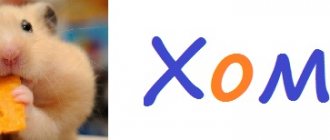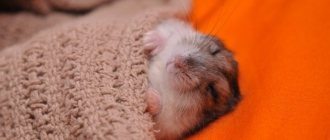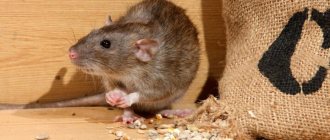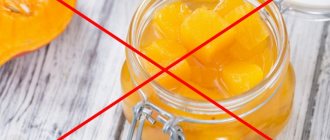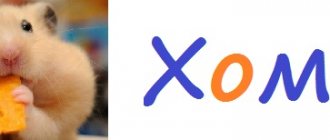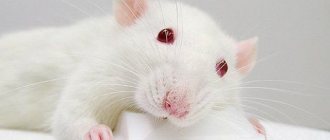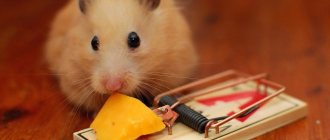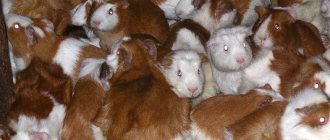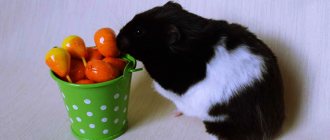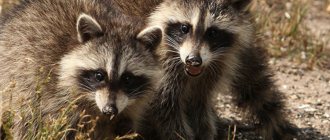The diet of your beloved animal should always be properly prepared. Normally, the body needs all the essential substances: proteins, fats, carbohydrates, vitamins, minerals. The diet of a wild hamster includes the following foods: berries, pieces of vegetables, grains, greens, larvae, residual carrion, and smaller animals. A pet needs high-quality food, so its menu includes special food mixtures, fruits, vegetables, berries, as well as fermented milk products (yogurt, cottage cheese) and other goodies.
Protein is an essential element for the body, but plant protein, unlike animal protein, will not fully saturate the body with essential amino acids. Can hamsters eat meat and fish, which are so rich in proteins? Which type of meat do you prefer?
Can hamsters eat meat?
There is a widespread belief among the owners of this animal that if you feed it meat, cannibalism will eventually manifest itself. In general, homas are herbivores. Nevertheless, they will gobble up meat products with joy.
Hamsters can have meat, but it must be fresh, lean and always boiled.
What will be harmful:
- pork;
- beef;
- fatty lamb.
Excess fat in the body negatively affects the liver of rodents, causes excess weight, and is also difficult for the stomach. An excellent alternative to meat would be a hard-boiled egg, rich in nutrients and harmless to the animal’s delicate digestive system.
Sausage is prohibited for hamsters
Can a hamster have sausage? Of course not. To make it, they use a full range of chemistry, spices and salts. Please take a look at this product. There must be fat content in it; without salt, the sausage would have no taste. Spices are out of the question. Substitutes, preservatives and flavorings make up a large portion of every cheap product. That's why hamsters can't eat it. The animal will not refuse it if offered to it. He refuses practically nothing at all. It even gnaws on wood and cages. Therefore, what your pet will eat depends only on you. Remember, proper nutrition affects not only your health, but also your life expectancy.
Cartoons often depict rodents eating cheese and sausage. Therefore, there is a stereotype that these are their favorite dishes. But that's not true. Both products are harmful. Can hamsters eat cheese? No. Can they have sausage? Also no. Remember, what you feed should not contain a lot of salts, spices, fats and chemicals. The latter may even kill the animal. Sausage can be given extremely rarely and only if it is real, of high quality and, accordingly, expensive. And that's a small piece. Anything cheap has many chemical substitutes, which can quickly lead to the death of a small organism.
Hamsters love to eat boiled meat, but salt and seasonings should be avoided. You need to choose a low-fat product (chicken, turkey). The animals will not refuse a small piece of homemade lard or shrimp.
Can hamsters eat chicken?
Chicken fillet is even necessary in feeding a hamster, as it contains various microelements (phosphorus, iron, potassium), vitamins of various groups. The healthiest part of chicken is a good diet breast. Chicken meat will only benefit the animal.
Protein is necessary for growth, maintaining the tone of internal organs, affects the regeneration of blood cells and is aimed at the correct functioning of the body as a whole.
Chicken should be given in the morning, as protein is a quickly digestible element. Considering that hamsters are active at night, such light food is perfect for him during daytime sleep.
Smoked and boiled-smoked sausages
They add a large amount of fat, salt, pepper and other flavoring additives to give the product a piquant, spicy taste. In addition to cooking, they undergo a smoking process, which leads to the development of cancer cells in the body.
Liver sausage is traditionally made from liver. In fact, starch and various food additives can be found in its composition. When this product is included in a hamster’s diet, the following diseases may develop:
- gastrointestinal disease;
- biliary tract;
- liver.
And if you need to include liver in your pet’s diet, then you need to give up sausage products.
It should be remembered that the following food additives are used in the manufacture of sausages:
- Sodium nitrite. Added to give the product a natural color. May cause the development of cancer.
- Phosphates. Improves the consistency of the product. Once in the hamster’s body, they do not allow calcium to be absorbed correctly. This can lead to various bone diseases.
- Vegetable fats. During the manufacturing process, they can turn into trans fats that are dangerous to the body.
Here is only a small list of the most dangerous ingredients for the body of a small animal. In fact, it is much more. The entire composition can be read on the product packaging.
Can hamsters have sausage? No, because any sausage product can cause the development of the following diseases:
- Heart and blood vessels;
- Liver, kidney, urolithiasis;
- Gastritis, ulcers and other stomach diseases;
- Various bone diseases;
- Inflammation of joints and articular tissues.
Can hamsters have sausage and frankfurters?
Sausage is a rather specific product for rodents. Human food is usually harmful to pets, but if you still decide to treat your pet, then consider the following:
- Boiled sausage is the best option for a hamster in terms of treats; it is made from lean meats, but contains a complex of spices.
- It is highly not recommended to give raw smoked sausage, as they contain a large amount of fat, starch and a lot of food additives.
- Although sausages are made from lean meat, they also contain a large amount of spices and various additives, which is completely undesirable for hamsters.
The result is that any sausage and frankfurters are harmful to the body of Djungarian and Syrian hamsters.
List of approved products
Rodents eat certain dietary foods. Some foods for hamsters can be deadly. Beginning hamster owners are recommended to feed their pets with special food, gradually accustoming them to a more nutritious diet. And we must not forget about clean water, to which the rodent should always have access.
Hard food
For Djungarian hamsters, you can buy special industrially produced grain mixtures. Manufacturers have already balanced all the necessary nutrients in them. There are simple foods that contain grass pellets, seeds, grains of some cereals and pieces of dried fruit. Other manufacturers enrich this composition with additional additives - vitamins, brewer's yeast, bone meal.
Important! The food should not contain candied fruits, honey, or raisins.
Recommended food for dwarfs:
- Chika-Bio "Food for Djungarian hamsters" . Good domestic food, which contains all the useful substances for hamsters. But the cost of this food is much lower than its foreign analogues. For one package weighing 900 g you will have to pay only 240-280 rubles.
- JR Farm Hamster . High-quality food without components harmful to hamsters. Among the benefits here are several sources of protein, the prebiotic inulin and yucca extract. The cost of a package weighing 800 g is 450-500 rubles.
- Vitapol and Lolo pets . Complete mixtures that can be fed to a hamster for a long time. The cost of a Vitapol package weighing 750 g is 500-550 rubles, a Lolo pets package weighing 500 g is 340-370 rubles.
In addition to dry grain food, Djungarian hamsters need additional sources of nutrients.
Vegetables
Vegetables are very important in the diet of small rodents, because they contain many substances that are beneficial for them. Hamsters are allowed to give:
- bell pepper;
- cucumbers;
- carrot;
- beets;
- radish;
- some types of cabbage;
- green pea;
- zucchini;
- pumpkin;
- Jerusalem artichoke.
The ideal option for a Djungarian hamster is vegetables with a high fiber content and minimal starch content. It is recommended to feed hamsters with them as often as possible.
Fruits and berries
Hamsters' diet must include fruits and berries. They are given them fresh or dried. But it is important to take into account the age (the pet must be older than 2 weeks), as well as the amount of food. If fresh fruits are given to dzhungarikas, the pit must be removed. This is especially true for the seeds of most fruits, which are a deadly poison for a hamster.
Allowed fresh fruits and berries:
- bananas;
- apples (cut into small slices);
- grape;
- strawberry;
- pears;
- peaches;
- apricots;
- plum;
- cherries;
- currant;
- barberry.
Strawberries should be given with caution. It often causes allergies in hamsters.
Rodents should not eat sour apples. Pears are fed only 1-2 times a month due to their laxative effect. Peaches, plums and cherries are also rarely produced. As for quantity, you should not give more than 5% of berries and fruits of the total food per day. If this norm is exceeded, the hamster will receive excess sucrose and carbohydrates. Dried fruits are soaked in water before giving to your pet. You can give dried bananas, raisins, dates, figs, dried apricots.
Greenery
To create a complete, balanced diet for a hamster, be sure to add greens. They are allowed to give:
- Meadow grasses.
- Garden greens.
- Forage grasses.
From garden greens, you can offer your fluffy dill, parsley, celery, lettuce, basil, carrot and beet tops. It is better not to give dill and parsley to pregnant or lactating animals. You should be careful with celery, because it contains a lot of excess liquid for the Djungarian hamster.
Meadow grasses - clover, dandelion, plantain, alfalfa, nettle, burdock. Such greens should be collected away from the road; you should be careful with herbs stuffed with chemicals.
You can also grow some greens for your hamster at home: oats, wheat, barley and other forage grasses.
Can hamsters fish?
Low-fat boiled fish can be given to little gluttons two to three times a week as a protein component of the diet. If you treated the homa with chicken meat, then you no longer need to give fish, since you need to feed it with one thing containing that amount of protein.
Seafood is rich in vitamins and iodine, and also contains virtually no heavy fats, so fish is a very healthy food. You can also add cod liver and fish oil to your hamster's diet (just one drop from a pipette). And although crab sticks can be classified as seafood, they are not suitable for fat people at all due to the high content of spices and other chemicals.
Benefits of seafood for your pet:
- strengthening the immune system;
- healthy silky fur;
- protection against colds;
- maintaining visual acuity.
Let's sum it up
Finding the right food for a hamster at home is not difficult; you just need to follow the basic rules: natural food should always be fresh and served in reasonable quantities. Products containing protein must be included in the diet daily in small quantities, alternating them with each other: cottage cheese, milk, fish, meat, eggs.
So, can hamsters eat meat? Be sure to feed it to your pet. Moderate consumption of this product will improve the condition of the coat, prevent vitamin deficiency, and have a positive effect on the general condition of the animal’s body.
Conclusion
To summarize, meat is a priority product in a hamster's diet. It is important to adhere to a few simple rules.
- Use boiled chicken more often, as this is the safest meat for the animal.
- Do not feed foods that are fatty, salty, peppery, or whose composition takes up more than five lines on the label.
- Boil lean meat and fish in a saucepan, cut into small pieces and put the cooled ones in a feeder.
- Treat your hamster to one type of protein food no more than 2-3 times a week.
How to make a hamster's diet
The hamster's menu must be designed so that its body receives proteins, fats, carbohydrates, vitamins, minerals, and water in the required quantities. After all, the needs of an animal change depending on age, period of life, and time of year. For example, at the end of winter - beginning of spring, the main menu is supplemented with fish oil (0.3 g), yeast (0.2 - 0.4), salt (0.2 - 0.3 g).
The daily portion of food depends on the size and age of the pet. Small and young hamsters eat more than older ones. For example, if an animal weighs 10–14 g, then per day it must eat a portion of food that is 70–80% of its weight, and sometimes more than 100%. As you age, the amount of food you eat changes.
A hamster's appetite depends on its condition, external conditions, and breed. The gastronomic preferences of each animal are different. Therefore, you need to make sure that he eats all the food in the feeder and does not choose tidbits.
Veterinarians have calculated the daily dose of various products depending on the season:
| Feed | Season | |||
| Winter | Spring | Summer | Autumn | |
| Vegetables | 50 g | 50 g | 50 g | 50 g |
| Roots | 15 g | 15 g | 10 g | 10 g |
| Dairy | 10 ml | 10 ml | 10 ml | 10 ml |
| Cereals | 20 g | 20 g | 20 g | 20 g |
| Greenery | — | — | 300 g | 300 g |
| Hay | 10 g | 10 g | — | — |
The daily amount of food depends on the age of the hamster:
| Products | Adult hamsters | Young animals |
| Cereals | 20 g | 10 g |
| Roots | 40 g | 20 g |
| Bran | 7 g | 5 g |
| Dairy | 10 ml | 5 ml |
| Greenery | 200 g | 100 g |
| Hay | 30 g | 20 g |
The animal should be fed with one type of food at the same time. For example, at 7 o’clock in the morning he eats greens, vegetables, herbs, protein foods, and at 19.00 – grain mixture, boiled cereals, some hay and treats. Pregnant females can eat 3–4 times a day at equal intervals. The evening meal should contain 40% of the daily diet.
Rodents sleep all day, and in the evening, that’s when they are fed. The hamster eats 1 time in the evening or 2 times - in the evening and in the morning.
It is important to follow a diet to avoid metabolic disorders.
If the hamster recovers quickly, then you need to temporarily exclude bread, sweets and fatty foods from the menu or significantly reduce their amount. You also need to make your pet move more.
Important! If your pet starts chewing on everything (including the bars of the cage), then give him special twigs and chalk for grinding down his teeth.
Can hamsters eat tuna?
Tuna is one of the fish that you need to be careful with. Unlike many other types of fish, tuna is high in mercury. This is because tunas eat other fish and grow very large. Small amounts of mercury, found in the smaller fish they eat, accumulate in tuna. Consuming too much mercury can even lead to mercury poisoning in humans! Because hamsters are much smaller, this danger is even more obvious to them.
Can hamsters have lard?
The food of rodents should be dietary and fresh. What is lard? According to Wikipedia, it is “solid animal fat deposited in animals during periods of intense nutrition.” It consists of triglycerides and an increased amount of fatty acid residues.
Article on the topic: Can hamsters eat black and white bread, pasta and crackers?
Already from one definition it becomes clear that such a product is prohibited for a hamster. Fat is extremely difficult for the baby's stomach to tolerate.
We store it correctly
Veterinarians sometimes hear that they fed only ready-made food from a pack, but the rodent has an intestinal disorder. Why? Follow the rules for storing the grain mixture. Damp seeds with signs of mold cause poisoning and painful conditions. And also, you need to carefully monitor the feeder when giving animal supplements - meat, eggs. If you haven't eaten it, you need to put it away so it doesn't disappear. Do not feed grass in bouquets in summer, just a little in the feeder. Hamsters drag greenery into the hole, it rots and gets dirty. A long stalk can get tangled around the paw, pinching the blood vessels until it becomes dead.
Can hamsters eat canned fish?
Many types of fish, such as tuna and sardines, are often stored in cans. While it is convenient and completely safe for us humans to consume in this manner, this is not the case for hamsters. Canned fish is usually preserved in either brine or vegetable oil, neither of which are suitable for your hamster. Brine contains a huge amount of salt, and too much salt in your hamster's diet is a recipe for disaster. Vegetable oils can make your hamster sick and should also be avoided.
Choose fresh cooked fish instead of canned fish.
Comments from 12 Monkeys
Online store 12 Monkeys
recommends a safe and balanced diet from the Russian manufacturer Laboratorkorm. The company has been supplying food for laboratory animals to research institutes and vivariums of educational institutions for 18 years and knows all the features of feeding hamsters and rats. A balanced composition is prepared in the form of granules from crushed cereals collected during the budding phase; meadow grasses - clover, alfalfa. The food is enriched with vitamins, antioxidants, and essential amino acids.
Meat, chicken and sausages in a hamster's diet
Pet owners often wonder about their nutrition. The same applies to hamster owners. Pet store food usually consists of grains, since grains are a very nutritious food. This is where questions arise about whether hamsters can eat meat, and not just plant foods. Hamsters can and do love to eat meat, but they can’t eat everything. Let's consider what kind of meat can be fed to domestic rodents.
Meat – harm or benefit?
Many owners of hamsters think that adding meat to their diet is not worth it, but the little pranksters need animal protein, which fills them with energy and helps them develop.
A little hamster just needs protein. Correctly calculating the diet is quite simple. You need to weigh your pet and give him food in the amount of 80 percent of his weight. Sometimes the diet can be 100 percent of the weight.
You should not give raw product to rodents; it may contain bacteria and parasites. It is pre-boiled in clean water. The ideal option is chicken, but pork and beef are best avoided. Fatty meat negatively affects the liver and causes obesity.
The food must be fresh, otherwise it will negatively affect the pet’s well-being.
